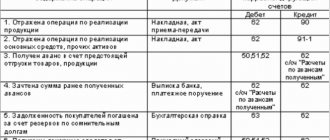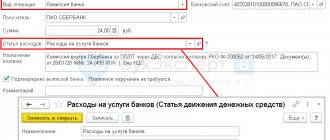It so happens that an organization has free funds, as a result of which a decision is made to temporarily withdraw them from circulation for normal activities and place them in a deposit bank account in order to receive interest. This article will discuss how to reflect this fact of economic life in accounting using the 1C 8.3 Enterprise Accounting 3.0 program.
But first, a small auxiliary methodological introduction.
What is a deposit or what will be discussed in the article?
From a legal point of view, we will talk about a bank deposit, the rules of which are established by the 44th chapter of the same name of the Civil Code of the Russian Federation.
There is a well-known contradiction regarding the accounting of deposits in the accounting regulatory framework. According to the Instructions for the Application of the Chart of Accounts (hereinafter referred to as the Chart of Accounts), the presence and movement of deposits is taken into account in subaccount 55.3 “Deposit accounts” of account 55 “Special accounts in banks”; on the other hand, according to paragraph 3 of PBU 19/02 “Accounting for financial investments”, deposits in credit institutions are classified as financial investments:
However, the IPPS does not directly provide for taking into account bank deposits in a special account 58 “Financial Investments”, therefore, without going further into theoretical reasoning, we will use account 55.03 “Deposit Accounts” to record deposits. At the same time, it is possible to use account 58 instead - this will not significantly affect the procedure for processing bank deposit transactions in 1C Accounting. In general, the specific method of accounting for deposits in an organization is established by the accounting policy.
Rules for reflection in accounting and reporting
In analytical accounting, credit accounts should highlight:
- types of loans,
- credit organizations.
It’s convenient when you can get information on any loan or bank from your account.
Interest on the loan is accounted for in the same accounts (66, 67) as the principal amount of the loan, but in a separate subaccount.
The balance sheet on lines 510 and 610 should show the amount of principal on the loan and interest on it.
When there are less than 12 months left until the end of the long-term loan agreement, it must be reflected in the financial statements as a short-term one.
Accounts for credits and loans. The Chart of Accounts provides account 66 for short-term loans and borrowings, and account 67 for long-term loans. Both accounts for credits and borrowings are passive, the balance on them shows the organization’s debt for the corresponding loans and borrowings.
Postings when receiving a loan. The receipt of a loan is reflected in accounting on the date when the money actually arrived in the organization's current account.
Accounting for accrual of interest on a loan - postings
When calculating interest, the accountant has three questions: when, in what amount and where? When and in what amount should I accrue and where should I assign it?
Answers to the questions: when and in what amount can be found in clauses 6, 8 of PBU 15/08. According to these paragraphs of the PBU, interest on loans must be reflected in the accounting period to which they relate.
Accounting for accrued interest on loans must be uniform and can be based on the terms of the contract, if the conditions do not differ significantly from the equal inclusion.
This means that interest on the loan must be accrued monthly. If the agreement provides for monthly interest payments, then the amount of accrued interest may be equal to the amount of interest paid. Accrual can be made on the date of payment.
What else is important to know: Refinancing a loan at a lower interest rate - conditions, documents, benefits, algorithm of actions
Also in this case, interest may be accrued twice a month: first on the payment date, then at the end of the reporting month.
But if interest, according to the agreement, is paid at a different frequency, for example, quarterly, then the accrual of interest in accounting must be carried out monthly and paid quarterly. The amount of interest accrued is determined by the calculation method.
Where should accrued interest be included in accounting? For the answer, let us again turn to PBU 15/08, to paragraphs 7 and 9. When, using a loan received, an organization builds or buys an investment asset, then the interest on the use of the loan is applied to the cost of this investment asset. In all other cases, interest is recognized as other expenses.
An investment asset, from the point of view of PBU 15/2008, is property that, before becoming a fixed asset, non-current or intangible asset, requires lengthy preparation and significant costs for acquisition, production or construction.
For example, an inexpensive machine that does not require installation: installed, plugged in, started using - will not be an investment asset. This means that interest on the loan in this case should not be included in the cost of the machine, but should be charged in full to account 91.
When taking into account accrued interest in the value of an investment asset, you need to remember the following restrictions:
- It is imperative to define the concept of an investment asset in the accounting policy; in PBU 15/08 the definition of this term is quite vague.
- The investment asset after production must be registered as a fixed asset or an intangible asset. For example, if an organization sells apartments, then after the apartments are accepted, they will be registered as finished products, and not as fixed assets.
- paragraph 11 of PBU 15/08 determines the procedure for accounting for interest on the use of a loan in cases where work on the production of an investment asset is suspended.
- Clauses 12, 13 of PBU 15/08 establish special rules for accounting for accrued interest in cases of commissioning of an investment asset or its use before commissioning.
Posting for interest calculation:
- Dt 91 (08) – Kt 66 (67) (sub-account “interest”).
- Dt 51 (52) – Kt 66 (67).
Accounting for loan costs
In order to obtain a loan, an organization sometimes incurs additional costs, for example, conducting an examination of the loan agreement.
Accounting for loan costs is kept separately from the principal amount of the loan. This means that loan costs must be reflected in accounts payable 60 or 76.
Loan costs:
- are reflected in the reporting period to which they relate (clause 6 of PBU 15/08).
- can be accounted for evenly over the life of the loan or written off at a time (clause 8 of PBU 15/08).
Posting for write-off of expenses: Dt 91 – Kt 60 (76)
Postings for loan repayment and interest for use
Loan payments are reflected in accounting on the date when the transfer was made from the organization's current account to repay the loan. The same applies to paying interest on a loan.
Postings for repayment of the principal amount of the loan: Dt 66 (67) – Kt 51 (52).
Postings when paying interest: Dt 66 (67) (sub-account “interest”) – Kt 51 (52).
Interest and loan costs in tax accounting
Interest for using a loan is taken into account in non-operating expenses (clause 2, clause 1, article 265 of the Tax Code of the Russian Federation). From 01/01/2015, after amendments were made to Article 269 of the Tax Code of the Russian Federation, the interest rate is not standardized.
An exception in terms of standardization is relations under controlled transactions. How to calculate interest for tax accounting in this case is written in detail in Article 269 of the Tax Code.
When reflecting interest in tax accounting, you must use the accrual method (clause 8 of Article 272 of the Tax Code). And take them into account:
- the last day of each month of the corresponding reporting (tax) period;
- day of return (repayment) of the loan.
There are no such detailed explanations in the Tax Code of the Russian Federation about other expenses that are associated with obtaining a loan.
What are loan costs from the Tax Code point of view? This is a third party service that is not related to production activities. Therefore, loan expenses in tax accounting can be included in non-operating expenses on the basis of clause 20, clause 1, article 265 of the Tax Code of the Russian Federation. But these expenses need to be justified.
Clause 3, clause 7, Article 272 of the Tax Code will help determine the date of reflection of loan expenses in tax accounting.
In order to correctly maintain accounting and tax records of received loans and borrowings, you need to present the situation as a whole. When you know the goals and terms of obtaining a loan, you have an agreement in hand, then all the questions that arise during the accounting process can be answered.
In companies using the general taxation system, interest must be recognized in non-operating expenses in the following order:
- or on the date of repayment of the loan, loan, deposit;
- or on the last day of each month during the entire term of using the loan or deposit.
If the company applies the simplified tax system, then interest must be recognized as expenses on the date of payment (clause 1, clause 2, article 346.17 of the Tax Code of the Russian Federation).
Making a deposit in 1C 8.3 Accounting
Let's assume the following business situation:
01/25/2016 Our organization entered into a bank deposit agreement and deposited 1,000,000 rubles into the deposit account. for a period of 6 months at 12% per annum. The agreement provides for monthly accrual and payment of interest.
Thus, in our example the postings will be involved:
- Debit 55.03 - Credit 51: transfer of funds from the organization to deposit;
- Debit 51 - Credit 55.03: entry reverse to the previous one, that is, the bank returns the invested funds.
Note: if the deposit is opened in foreign currency, then account 52 “Currency accounts” corresponds with the account for accounting for financial investments.
- Debit 76 - Credit 91.1: accrual of incoming interest on the deposit;
- Debit 51 - Credit 76: payment of interest on the deposit.
The example uses a demo base based on the Enterprise Accounting configuration, edition 3.0 (3.0.43.241).
Transfer of funds to a deposit in 1C 8.3
To formalize the transaction of transferring funds from the organization’s current account to a bank deposit in 1C Accounting 3.0, use the document “Write-off from the current account.” To create it, let's turn to the Bank Statements journal in the Bank and Cash Department - command group Bank - Bank Statements command:
At the top of the form of this journal there are buttons for manual (Receipt and Write-off) and automated (Upload - starts processing the exchange of documents with the bank) input of bank documents:
Let's manually create the document Write-off from the current account. Accordingly, by clicking the Write-off button, a new document form will open, all the necessary details of which must be filled out:
- First, you need to select the appropriate Operation Type - in our case it will be Other write-off.
- Next, in addition to the basic standard details, the debit account is indicated - 55.03, and the corresponding analytics are also filled in in the form of a bank account and cash flow item.
- At the same time, the need to indicate the type of SDDS for each specific monetary transaction is established by the organization in accordance with the accounting regulatory framework.
At the output we have the expected posting, reflecting the transfer of funds to the deposit (the Show movements button):
Accrual and receipt of interest on deposits in 1C 8.3
In accounting, in accordance with paragraph 7 of PBU 9/99, interest on a deposit is recognized as other income. In tax accounting, interest on deposits is classified as non-operating income (clause 6 of Article 250 of the Tax Code of the Russian Federation) and is recognized as received and included in the corresponding income at the end of each month, regardless of the date of their payment (clause 6 of Article 271 of the Tax Code of the Russian Federation). Therefore, in this general case, there will be no discrepancies in the reflection of deposit interest between these two types of accounting.
Provided that the amount of the bank deposit was received by the bank on January 25, 2016. and returned by the bank on June 24, 2016, the distribution of accrued interest by month will be calculated as follows:
The registration of the operation of calculating interest on a bank deposit in the 1C Enterprise Accounting 8.3 program is carried out using a special document Operation. Its creation occurs from the corresponding list: section Operations - group of commands Accounting - command Operations entered manually:
Next, in the form that opens, click the Create button and select Operation from the drop-down menu. As a result, a new document form will open, all the necessary details of which must be filled out.
In the header of the document (the upper non-tabular part) the general details for transactions (if there are several) are filled in.
To add a transaction to the tabular part of the document:
- Click the Add button;
- We fill out the necessary debit and credit accounts, as well as their analytics;
- We indicate the amount. When filling out this field in 1C 8.3, the document header details “Transaction Amount” will be automatically filled in. When the field value is changed or a new line is added, the “Transaction Amount” attribute will be automatically recalculated.
The document Operation in 1C 8.3 generates accounting entries directly:
Next, it is necessary to take into account in 1C Accounting 3.0 (8.3) the actual payment by the bank of interest on the deposit. The document Receipt to current account is suitable for this purpose. Let's create it by clicking on the button Receipt of the journal of bank statements (see above for how to get there), and fill in the details of the new document form that opens:
- First, you need to select the appropriate type of operation - in our case, Other receipt is suitable.
- Further, in addition to the basic standard details, the loan account is indicated - 76.03.
- The corresponding analytics are also filled in in the form of a counterparty, agreement and cash flow item. At the same time, the need to indicate the type of SDDS for each specific monetary transaction is established by the organization in accordance with the accounting regulatory framework:
At the output we have the expected posting, reflecting the receipt of interest on the deposit to the current account:
The above operations of accrual and receipt of interest on the deposit must be carried out in the 1C 8.3 Accounting 3.0 program on a monthly basis according to the contract schedule:
Return of deposit in 1C 8.3
So, at the end of the term of the bank deposit agreement, the bank transferred funds from the deposit account to the organization’s current account, that is, returned the money deposited.
This operation is formalized in 1C Accounting 3.0 on the basis of a bank statement confirming this fact using the document Receipt to current account already mentioned above:
- We indicate the type of operation Other receipt;
- Loan account – 55.03;
- Next, fill in the necessary analytics for the accounting accounts:
Result of the document:
We will generate reports for verification in the 1C 8.3 program: Turnover balance sheet for accounts 55.03 and 76 for the period of deposit settlements and at monthly intervals:
Postings for interest on deposits in accounting
Let's look in more detail at examples of how to reflect the accrual of interest on a deposit in transactions.
Example 1
The organization VESNA LLC transferred 500,000.00 rubles to the bank on March 1, 2021. for deposit. According to the terms of the agreement, the deposit period is 12 months, therefore, the bank must return the funds on February 28, 2021.
Interest on the deposit is accrued monthly at a rate of 9% per annum with monthly capitalization of interest. The total amount of accrued interest is paid at the end of the term along with the deposit amount.
Calculation of the amount of income, deposit and payment scheme for accrued interest on the deposit:
Postings for accounting for the deposit amount and interest on the deposit:
| Debit Account | Credit Account | Transaction amount, rub. | Wiring Description | A document base |
| 58 | 51 | 500 000,00 | VESNA LLC transferred funds to deposit | Bank statement |
| 58 | 91.01 | 3 750,00 | Interest accrued on the deposit for the month of March (500,000.00 * 9% /12) | Deposit agreement |
| 58 | 91.01 | 3 778,13 | Interest accrued on the deposit for the month of April ((500,000.00+3,750.00) * 9% /12) | |
| etc. | ||||
| 51 | 58 | 546 903,45 | The bank returned the deposit amount with the total amount of accrued interest (500,000.00+46,903.45) | Bank statement |
Example 2
The organization VESNA LLC transferred 500,000.00 rubles to the bank on March 1, 2021. for deposit. According to the terms of the agreement, the deposit period is 12 months, therefore, the bank must return the funds on February 28, 2021.
Simple interest on the deposit is accrued monthly at a rate of 9% per annum. Interest on the deposit is accrued starting from the day following the day of transfer of funds, including the day the bank returns the funds to the depositor.
Calculation of the amount of income, deposit and payment scheme for accrued interest on the deposit:
Postings for accounting for the deposit amount and interest on the deposit:
| Debit Account | Credit Account | Transaction amount, rub. | Wiring Description | A document base |
| 58 | 51 | 500 000,00 | Funds transferred to deposit | Bank statement |
| 76 | 91.01 | 3 750,00 | Interest accrued on the deposit for the month of March (500,000.00 * 9% /12) | Deposit agreement |
| 51 | 76 | 3 750,00 | The accrued interest on the deposit for March is listed | Bank statement |
| etc. | ||||
| 51 | 58 | 500 000,00 | The deposit amount was returned by the bank | Bank statement |






